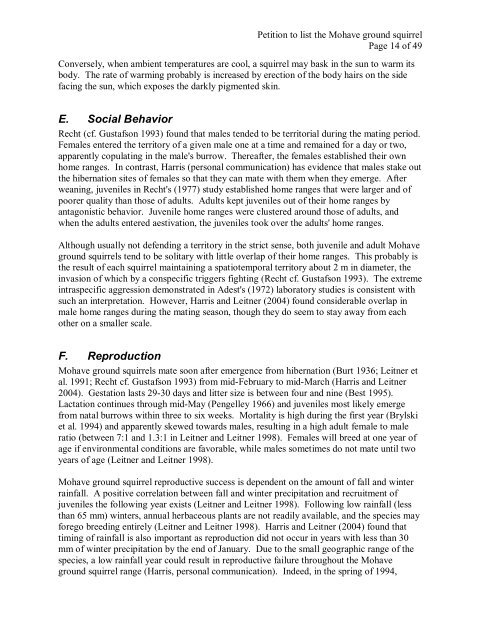Petition to list the Mohave Ground Squirrel - Defenders of Wildlife
Petition to list the Mohave Ground Squirrel - Defenders of Wildlife
Petition to list the Mohave Ground Squirrel - Defenders of Wildlife
Create successful ePaper yourself
Turn your PDF publications into a flip-book with our unique Google optimized e-Paper software.
<strong>Petition</strong> <strong>to</strong> <strong>list</strong> <strong>the</strong> <strong>Mohave</strong> ground squirrel<br />
Page 14 <strong>of</strong> 49<br />
Conversely, when ambient temperatures are cool, a squirrel may bask in <strong>the</strong> sun <strong>to</strong> warm its<br />
body. The rate <strong>of</strong> warming probably is increased by erection <strong>of</strong> <strong>the</strong> body hairs on <strong>the</strong> side<br />
facing <strong>the</strong> sun, which exposes <strong>the</strong> darkly pigmented skin.<br />
E. Social Behavior<br />
Recht (cf. Gustafson 1993) found that males tended <strong>to</strong> be terri<strong>to</strong>rial during <strong>the</strong> mating period.<br />
Females entered <strong>the</strong> terri<strong>to</strong>ry <strong>of</strong> a given male one at a time and remained for a day or two,<br />
apparently copulating in <strong>the</strong> male's burrow. Thereafter, <strong>the</strong> females established <strong>the</strong>ir own<br />
home ranges. In contrast, Harris (personal communication) has evidence that males stake out<br />
<strong>the</strong> hibernation sites <strong>of</strong> females so that <strong>the</strong>y can mate with <strong>the</strong>m when <strong>the</strong>y emerge. After<br />
weaning, juveniles in Recht's (1977) study established home ranges that were larger and <strong>of</strong><br />
poorer quality than those <strong>of</strong> adults. Adults kept juveniles out <strong>of</strong> <strong>the</strong>ir home ranges by<br />
antagonistic behavior. Juvenile home ranges were clustered around those <strong>of</strong> adults, and<br />
when <strong>the</strong> adults entered aestivation, <strong>the</strong> juveniles <strong>to</strong>ok over <strong>the</strong> adults' home ranges.<br />
Although usually not defending a terri<strong>to</strong>ry in <strong>the</strong> strict sense, both juvenile and adult <strong>Mohave</strong><br />
ground squirrels tend <strong>to</strong> be solitary with little overlap <strong>of</strong> <strong>the</strong>ir home ranges. This probably is<br />
<strong>the</strong> result <strong>of</strong> each squirrel maintaining a spatiotemporal terri<strong>to</strong>ry about 2 m in diameter, <strong>the</strong><br />
invasion <strong>of</strong> which by a conspecific triggers fighting (Recht cf. Gustafson 1993). The extreme<br />
intraspecific aggression demonstrated in Adest's (1972) labora<strong>to</strong>ry studies is consistent with<br />
such an interpretation. However, Harris and Leitner (2004) found considerable overlap in<br />
male home ranges during <strong>the</strong> mating season, though <strong>the</strong>y do seem <strong>to</strong> stay away from each<br />
o<strong>the</strong>r on a smaller scale.<br />
F. Reproduction<br />
<strong>Mohave</strong> ground squirrels mate soon after emergence from hibernation (Burt 1936; Leitner et<br />
al. 1991; Recht cf. Gustafson 1993) from mid-February <strong>to</strong> mid-March (Harris and Leitner<br />
2004). Gestation lasts 29-30 days and litter size is between four and nine (Best 1995).<br />
Lactation continues through mid-May (Pengelley 1966) and juveniles most likely emerge<br />
from natal burrows within three <strong>to</strong> six weeks. Mortality is high during <strong>the</strong> first year (Brylski<br />
et al. 1994) and apparently skewed <strong>to</strong>wards males, resulting in a high adult female <strong>to</strong> male<br />
ratio (between 7:1 and 1.3:1 in Leitner and Leitner 1998). Females will breed at one year <strong>of</strong><br />
age if environmental conditions are favorable, while males sometimes do not mate until two<br />
years <strong>of</strong> age (Leitner and Leitner 1998).<br />
<strong>Mohave</strong> ground squirrel reproductive success is dependent on <strong>the</strong> amount <strong>of</strong> fall and winter<br />
rainfall. A positive correlation between fall and winter precipitation and recruitment <strong>of</strong><br />
juveniles <strong>the</strong> following year exists (Leitner and Leitner 1998). Following low rainfall (less<br />
than 65 mm) winters, annual herbaceous plants are not readily available, and <strong>the</strong> species may<br />
forego breeding entirely (Leitner and Leitner 1998). Harris and Leitner (2004) found that<br />
timing <strong>of</strong> rainfall is also important as reproduction did not occur in years with less than 30<br />
mm <strong>of</strong> winter precipitation by <strong>the</strong> end <strong>of</strong> January. Due <strong>to</strong> <strong>the</strong> small geographic range <strong>of</strong> <strong>the</strong><br />
species, a low rainfall year could result in reproductive failure throughout <strong>the</strong> <strong>Mohave</strong><br />
ground squirrel range (Harris, personal communication). Indeed, in <strong>the</strong> spring <strong>of</strong> 1994,
















